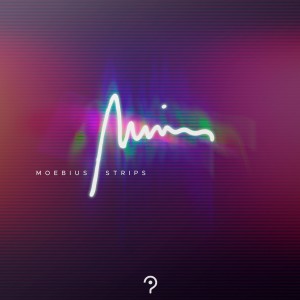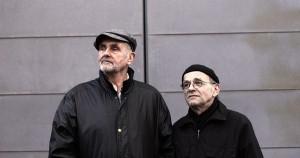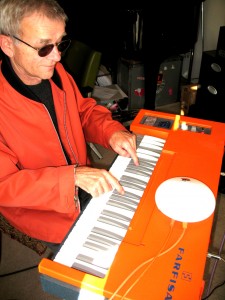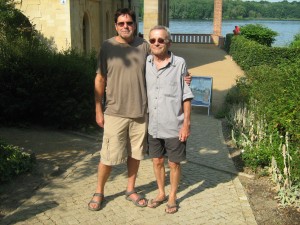
Artist
IMAGES: To download, click above. Photo one by Irene Moebius. Photo two by Tim Story. Photo three by Christa Fast. Photo four by Irene Moebius.
CURIOUS MUSIC LINKS:
Website
Twitter
Instagram
Facebook
YouTube
Tim Story
Curious Music
As many an inquisitive kid knows, a Moebius strip is a loop with a half twist. Draw a continuous line on one side, and it magically connects with itself. The two sides of a strip of paper somehow become just one. Serious mathematics aside, it’s a marvel that seems to reside slightly and delightfully outside our predictable 3-D universe. A fitting comparison no doubt to the music of Dieter Moebius, a distant relative of the famous 19th century German theorist who revealed the quirks of his namesake ‘strips.’ With a legacy of singular music that includes seminal work with Brian Eno, Conny Plank, as a member of the krautrock supergroup Harmonia and perhaps most memorably with Hans-Joachim Roedelius in the duo Cluster, Dieter “Moebi” Moebius left us, with his passing in 2015, a rich musical universe equally beguiling and subversive.
Moebius Strips is American composer/sound artist Tim Story’s unique homage to that legacy—an immersive multi-channel audio installation assembled from the trove of inspiring sounds and methods the Swiss-German pioneer left behind. Simultaneously respectful and playfully inventive, Story draws upon his decades-long friendship with Moebius for inspiration, imbuing the whole with the American artist’s fascination with the malleability of sound and context, and a desire to bridge the divide between listener and composer.
Using Moebius’s sounds and loops, Story reimagines his friend’s inventive and slightly skewed aural universe as an engaging and elusive three-dimensional sonic sculpture. Removed from their original contexts, these loops recombine in hypnotic arcs and visceral squiggles that are mischievous, unorthodox, both warm and unsettling. Moebius loved collaboration, and Story approaches Moebius Strips with a similar sense of community. Moebi’s music continues to inspire a generation of sound explorers and composers. Story honors those connections by inviting a distinguished group of artists to add their voice and interact in their own unique ways with Moebi’s visionary music.
Preserving both Moebius’s material and the new interactions on individual layers of the installation, Story allows the audience a rare opportunity to actively explore these unique sound sculptures. Blurring the traditional barriers between composer and listener, Moebius Strips effectively removes the tyranny of an ‘authoritative mix’, and frees the participant not only to hear each layer individually, but to meaningfully participate in the composition itself by the way they physically move within the soundstage. Deliberately smudging preconceptions of authorship and appropriation Story invites the listener to ask who is the creator of these tone poems, if one created all the sounds, another put them together, and yet another interacts with them? Story is happy to leave these questions, like Moebi’s music, willfully ambiguous.
Like his famous forebear, Moebius was no stranger to loops, using them often, and uniquely, in his sonic explorations. Unlike many others who would trim the ends into a seamless rhythmic flow, Moebi often cut them abruptly, unapologetically leaving them to stutter in idiosyncratic patterns as the beginnings rejoin the ends. This aesthetic, which deliberately accentuating the artificial editing and repetition of events, exposes a kind of meta examination of the idea of looping itself. It’s also a clear reminder of Moebi’s sly, subversive humor, and his disdain for the sterile, rigid ‘perfection’ of much contemporary music. Into an electronic music scene of strict academic ‘purity’ on one hand, or softly drifting sequences of cosmic grandeur on another, Moebi injected a much-needed jolt of dada, a bracing ‘punk’ sensibility that still feels unique and alive.
Moebius’ irreverent love of pure sound also figures prominently here. As a collector of sounds, both natural and unnatural, Moebi often recorded the odd sonic detritus of everyday life, adding them to his sound banks for later use. Squeaky door hinges, noisy industrial machines, the whir of a digital camera powering on and off, all become part of the musical landscape. Finding the innate rhythms and sonorities in these unlikely elements, Moebius turned them into virtual instruments. Far from mere sound effects, they became the structure and fabric of his compositions—happily coexisting with the conventional sounds of keyboards, electronics, percussion—speaking to the listener in a language both alien and familiar. Like words in a narrative, these sounds would often pop up in multiple projects and in multiple contexts, suggesting entirely new rhythms and associations depending upon their current surroundings.
Story brings an obvious affection for his friend’s unique modus operandi to Moebius Strips. Thirty years of friendship, countless conversations and a decade of collaboration make Story a particularly empathetic ambassador to Moebius’ sonic worlds. Working closely with Moebi’s widow Irene, Story combined hundreds of sounds, motifs and riffs from the artist’s archive with raw material from the many Moebius collaborations that Story himself had been a part of over the years.
Immersing himself in the material, Story began his compositions, exploring in new ways the inherent rhythms, musical gestures, and sonic connections that had inspired his friend.
“Working together, I remember the great deal of trust we shared,” says Story. “That trust gave me the motivation to take this project on. Exploration, as well as trial and error, was always an unspoken joy for us both. It’s incredibly liberating to know that Moebi would have wanted me to have fun with this – to approach his sounds as a playground rather than a museum.”
“Moebi left us way too soon. But his music remains vivid and unforgettable, and it’s such a pleasure to present it again in a physical space where it can be actively explored. Inviting other talented artists to interact and add new perspectives–new life–to this music, reminds me again of what always defined the man and his art – humor, curiosity, and profound humanity.”





